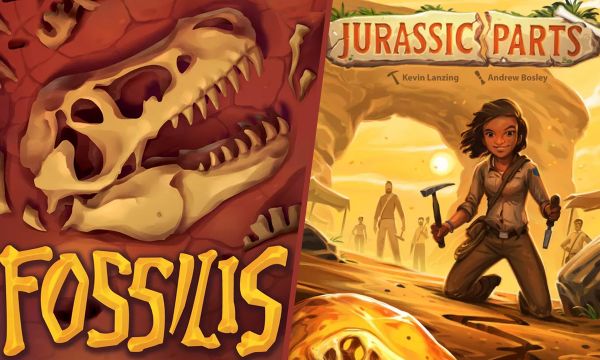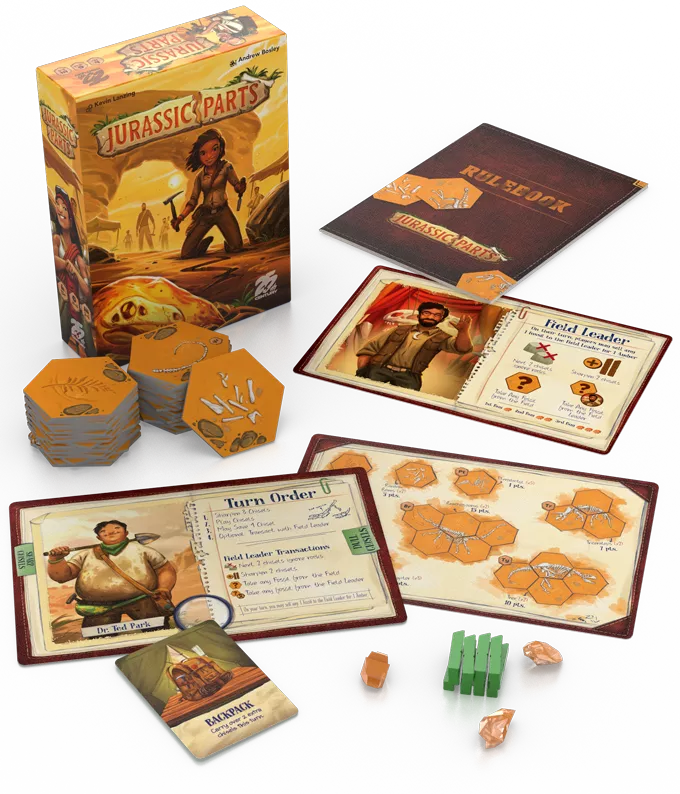Set Collections: Go on Archaeological Expeditions with Fossilis and Jurassic Parts

Welcome to the first entry in a series of examining board games from a different point of view. Rather than breaking down one game on its own, this series hopes to explore multiple games with some common traits (theming, mechanics, designers, etc.) worth exploring. The purpose is not to compare and provide an answer on which game is better, but rather to highlight why both are appealing games. It only seemed fitting to begin this with two games that have hit the table a lot in recent months: Jurassic Parts and Fossilis.
Making Acquaintances
Since we’ll be going on some archaeology digs with these games, let’s first explore who we’re tagging along with.

Jurassic Parts (image provided by the publisher)
Jurassic Parts is by designer Kevin Lanzing and published by 25th Century Games. It’s largely an area control and set collection game where players will choose a character and do their best to chisel away pieces of an archaeological site in the hopes of piecing together the skeletal remains of various dinosaur species. This is done by placing chisels of a player’s chosen color across a grid made up of hexagonal tiles (half face-up, the other half face-down). Once enough chisels have been used across players to carve out a section of the dig site, those pieces are turned face-up (if any are face-down) and divvied up among the players who placed them. The player with the most chisels claims half the titles (rounding up with odd numbers), second place taking half of the remaining stack, and third getting any remaining tiles (if applicable). The idea is to find enough skeleton pieces to create complete builds of specific dinosaur species worth different point amounts. Finishing a skeleton rewards players with an amber, which can be used for benefits and bonus actions throughout the game. Collecting plants also awards points. The player with the most points from skeletons (including one point for each uncompleted tile), plants, and remaining amber to determine the winner.

Fossilis (image provided by the publisher)
Fossilis is designed by David Alberto Diaz and published by Kids Table Board Games. Players will be navigating a rocky archaeological dig site, removing sand, clay, and stone to uncover valuable dinosaur bones. Players will have four action points in which to move their meeple around the site, move pieces of sand, clay, and rock, and to collect the goodies underneath. These actions may be worth 1, 2, or 3 action points depending on what they do (for example, moving one space on the board is one action point, pushing a stone a space is worth three action points). Digging bones out of the board costs plaster. There is a clever mechanism on claiming plaster that acts as the timer in between rounds to keep the game moving. Plaster and other benefits can be gained via Tools and Supplies cards, which are purchased by using symbols from claimed sand, clay, and stone tiles that have been moved off the board. Much like Jurassic Parts, Fossilis is trying to get players to create sets of dinosaur bones to complete cards for points. Each piece has its own worth when placed on a card (or a slightly less amount left unplaced), and completing a card’s requirements is worth a total more than the pieces combined. Points are awarded for completed dinosaurs, leftover bones, and sets of completed dinosaur cards, with the highest total being declared the winner.
How Are They Alike
It’s not hard to see the similarities between the two games both in theme, but also in art direction. The design for both games includes earthy colors steeped in traditional archaeological touchstones. Apolline Etienne designed Fossilis, with Andrew Bosley as well as Crimzon Studio helping the direction of Jurassic Parts. Yet these muted tones do not make for two dusty, dirty-looking games. Both games are designed to immerse players — specifically younger gamers — into a theme that is appealing to their very nature of digging in the dirt, finding treasures, and having fun while doing so. Jurassic Parts uses a good smattering of orange and bronze to bring some character to its grid, while the sand, clay, and stone tiles in Fossilis really make its 3D board pop. The symbology for both games is easy to decipher and that’s important when playing with younger or newer gamers who will always have follow-up questions when playing.
What Sets Them Apart
The immediate lure of Fossilis is its toy factor. As mentioned, its board is a big, 3D square that has plastic bones and tools that are hidden underneath thick, sturdy tiles. There’s just as much fun to be had in the setup as there is excavating the site during the game. The tweezers used to dig out the fossils will also bring back some nostalgic feelings for older gamers without the nightmares of a tonal buzz and bulb nose flashing red.
This isn’t to say Jurassic Parts doesn’t have its own charms. The game allows players to cast themselves as a unique character with their own histories. The characters are charming, body and gender positive, and provide players a chance to have a little extra fun getting to know — and perhaps embody — their chosen characters. Bosley’s art style is both playful and yet sophisticated. And the grid can be shaped however players see fit, so long as half of the tiles are placed face-down, leading to some interesting shapes that can increase the competition.
However, the games certainly cater to different audiences. Kids Table is great at creating games for children that have appeal to the adults who play with them. Some Kids Table games are really fun for adults without the children, too. That said, Fossilis is one of the biggest kid-friendly first games from the publisher (and that’s not an insult). Its action selection mechanism is so simple that children understand it and keep track of it without much help, and this is great for children who may transition into more complex games and situations as they get older. Fossilis is recommended for players aged 8 and up, but my 6-year-old had no issues with the teach (personal note: I’m a horrible board game teacher). Jurassic Parts is a little more sophisticated in its area control mechanism, which is why it’s recommended for ages 10 and up, and I’ve found this to hold true. That said, it plays much quicker than Fossilis in most playthroughs, even with an older, more experienced crew playing both games.
Final Thoughts
Both of these games are complimentary due to how they present game styles and explore their theme. Fossilis will give inexperienced gamers a chance to think through turns, understand how one action may affect the next action without much penalty, and get a general understanding of how those actions also build upon each other.
Jurassic Parts has a bit more risk, especially with its area control elements. While there can be some instances where players disrupt other players in Fossilis (for example, a player may remove a tile from the board that is occupied by another player, therefore taking them off the board and costing them an action to get back on the board during their next turn), chisel placement in Jurassic Parts can get cutthroat, especially when skeletons that may aid the completion of in-process sets are up for grabs. With a limited number of chisels, it’s also wise to optimize their placement from turn to turn, but also — not dissimilar to games such as Carcassonne — be tricky in manipulating where the action goes to one’s advantage and another’s disadvantage.
That said, neither game is punishing and offers ways to counterbalance any negative impacts. And both games offer enough differences and ideas that they are competing for shelf space in households where limited space and overlapping themes or mechanics may mean one has to go. Both are great casual games that offer just enough challenge to help you ease friends and families into more complex fare, but neither abandon the fun of just enjoying them as they are over and over again.









